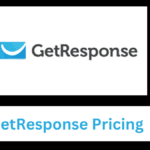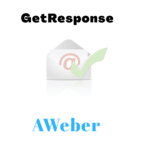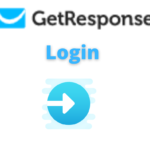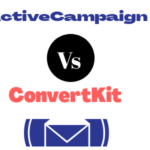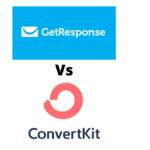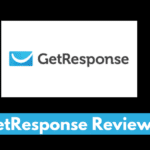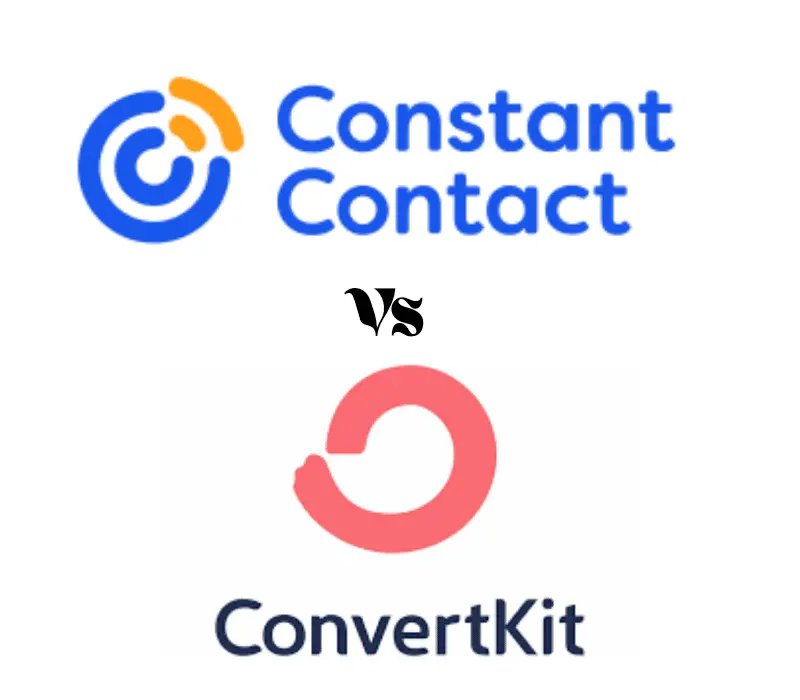
Constant Contact Vs ConvertKit is a common comparison people make when they’re not sure of which of the email marketing tools to use. The fact is that both email marketing platforms are good.
They offer great services depending on what you need them for. I have explored both tools in my years as a digital marketer and here’s what I noticed. ConvertKit is designed for creators like bloggers, YouTubers, podcasters, social media influencers, artists, and other creators.
It offers features that allow them to grow their audience and subscribers and at the same time make a living from their creative works. Constant Contact on the other side is suitable for businesses that are in search of smart features in email marketing.
Features that can allow them to engage customers, boost their ecommerce, and social media sales. Same time give them access to advanced marketing tools. With that being said, I believe that you now an idea of what these email marketing software can do. But that’s not enough to make a decision.
This piece will help you make the best decision between the two by comparing their features, key features to look out for in any email marketing tool, pricing plans, customer support.
Let’s dive in
What’s Constant Contact?
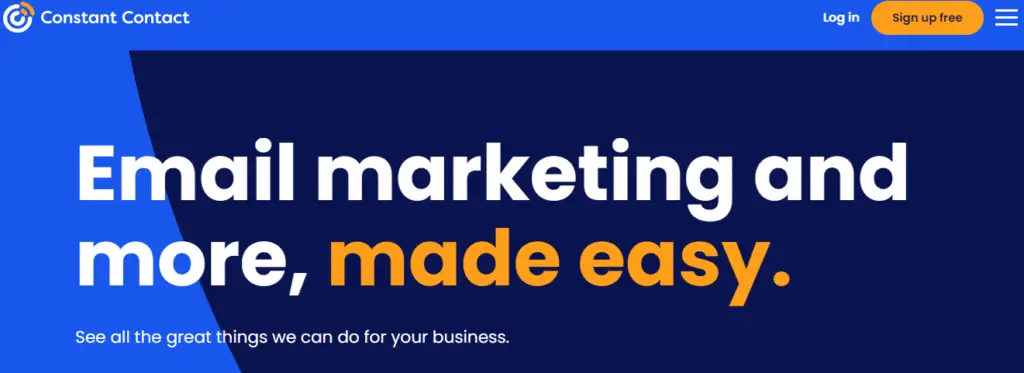
Constant Contact is an email marketing tool for small businesses that are in need of marketing tools to grow their customer base and boost sales.
Since 1995 when it first started as an online marketing tool, it has helped small businesses compete with their large competitors in terms of engaging customers and driving more conversion.
Today over 5 million businesses worldwide trust Constant Contact as their email marketing software. There’re striking features that you can use to grow your business.
Keeping your customers engaged and building relationships with them are simple. Welcome emails can be sent to new subscribers, contacts segmented, email series triggered, and emails resent to subscribers who didn’t open them.
Your ecommerce business is not left out as Constant Contact has features to grow it. There’re features with which you can use to capture new leads, segment them, and automated emails that will lead to conversion.
What about social media marketing?
You can run Facebook and Instagram ads from your Constant Contact account to drive traffic to your landing pages or websites.
Your social media campaigns can be scheduled with access to making updates, responding to comments, direct messages, and mentions.
Other features of Constant Contact are:
- Smart drag and drop editor to design awesome emails and landing pages.
- Contact list management which makes easy to add new contact through your website, and social media accounts. You can even upload contacts from Salesforce, Excel, and Outlook.
- Monitor the performance of your email campaign in real-time.
- Manage donations, online surveys, coupons, donations, from a single place.
- Your email marketing can be on autopilot through scheduled, personalized, and targeted emails.
What about ConvertKit?

For a blogger who has a blog, YouTuber, who makes money from his YouTube video views, ConvertKit has the features you need to succeed. Even Podcasters, Artists, Course Creators, and other creators aren’t left behind.
Over 250,000 creators trust ConvertKit as their email marketing tool. It offers you different email and landing page templates that are customizable.
Beyond sending out emails, you can automate email funnels to target a segmented contact in your list.
This’s to drive conversion to your digital products and membership subscription. You can even let your fans and audience know about your new project and how it can be helpful to them.
Overall, ConvertKit has the tools you need to turn your subscribers, fans, and audience into paying customers.
Some of the features of ConvertKit are:
- Create email sign-ups and exchange freebies to capture visitors into your email list.
- Make use of the email designer to create emails that can convert. Edit your emails, add images, emojis, videos with ease.
- Design beautiful landing pages that respond perfectly on any kind of device. You’ve access to other 100,000 free stock photos from Unsplash.
- Automate your email to target a segmented contact with the right content and at the right time.
- Sell digital products like ebooks, courses, membership subscriptions, songs, etc through ConvertKit commerce.
- Now let’s look at the key factors that matter when choosing an email marketing tool. Then make a detailed comparison between Constant Contact Vs ConvertKit with regards to them.
1. Integration
Third-party apps are important to get the best of your email marketing tool. It’s one factor to consider when deciding to choose either ConvertKit or Constant Contact.
No matter how robust an email marketing software is, if it doesn’t integrate with other relevant marketing apps, you can’t do more with it.
Constant Contact: Integration
Constant Contact integrates with third-party apps that are relevant in marketing. This connection is made easy with Zapier –another third party app that helps Constant Contact integrate with other apps.
Some of these apps are Eventbrite, Office 365, Formstack, Shopify, Etsy, Woocommerce, Bigcommerce, eBay, etc.
ConvertKit: Integration
It integrates with numerous third-party apps. These apps are organized according to tags making it easy for users to locate and integrate apps in any category.
You can also make use of the search bar to look for any app you may like to connect with ConvertKit. Some of the apps that integrate with ConvertKit are Teachable which is one of the online course software.

Shopify an ecommerce giant, Stripe for payment processing. Others are LeadsBridge, JetpackCRM, KingSumo, ViralSweep, Acuity Scheduling, etc.
Verdict: Convertkit wins
Both integrate with tools relevant to marketing but ConvertKit connects with more tools.
Also, its third-party apps are organized according to categories making it easy for a beginner to identify an app to integrate with ConvertKit.
2. Ease Of Use
How easy it’s for you to use any of these email marketing tools should matter to you. The question should be – Can I launch emails, design landing pages, automate emails, analyze the performance of email campaigns on my own?
Are the terminologies of each of the email marketing tools easy to understand? How is the learning curve like?
Constant Contact: Ease Of Use
Once you’ve signed up for Constant Contact with your email address and logged into your account, you’ll be taken to your dashboard.
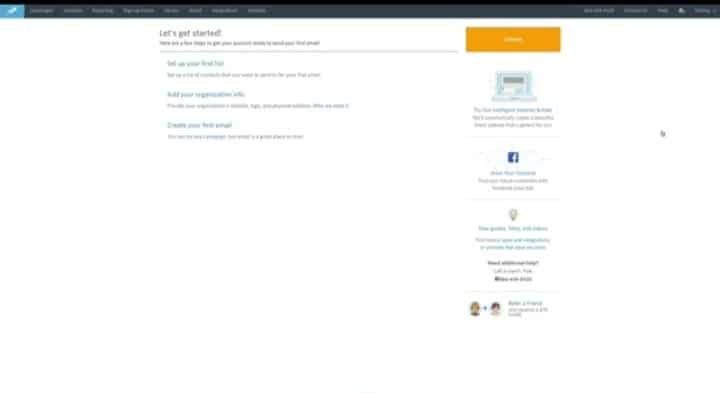
This’s where you create your email list, design your landing pages, and carry out other email marketing activities. Constant Contact made it simple that your dashboard is easy to navigate.
At the top of your dashboard, you’ll see an option to create a list which is the first step to creating an email sign-up form.
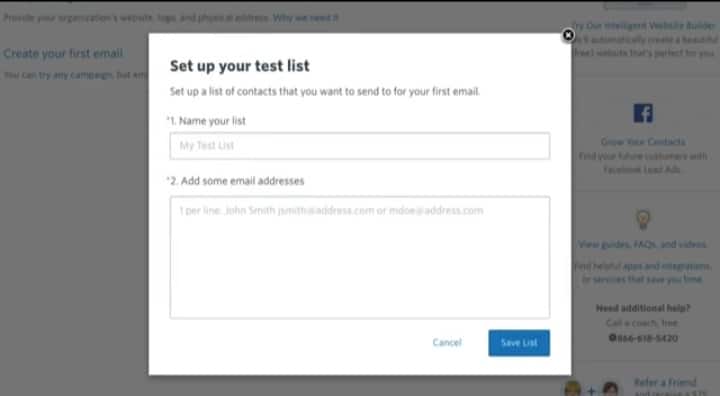
Designing your landing pages is made simple with different landing page templates available to you which are customizable.
Constant Contact user interface is beginner-friendly and anyone can handle it.
ConvertKit: Ease Of Use
At the point of creating your account with ConvertKit. You’ve the option to choose if you’re migrating from another email marketing tool or you’re a beginner to email marketing.
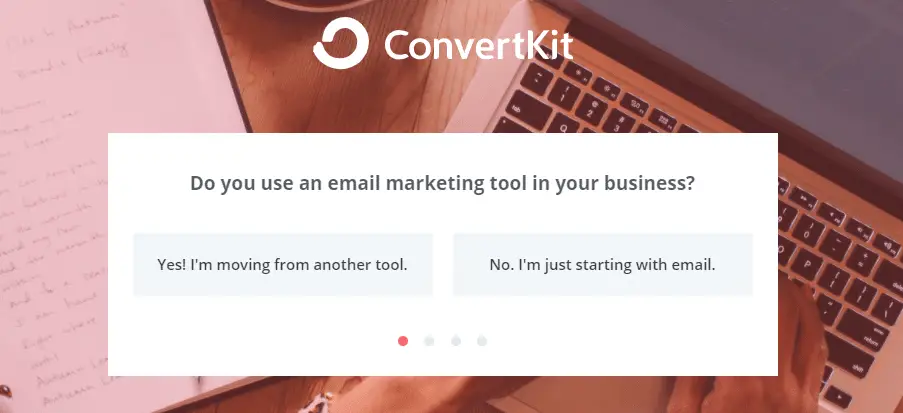
After you’ve created your account and logged in, you’ll be taken to your dashboard. On the right-hand side, you will see a list of actions you can perform.
E.g create a sequence, create a form, embed a form on your website, import subscribers, connect forms and sequence, etc.
When it comes to designing your email and landing pages, there’s a drag and drag editor which makes it easy for you. Also, the email and landing page templates are customizable.
Verdict: No winner
Both email marketing tools are easy to use. They’re beginner-friendly and anyone can handle them without coding skills or being tech-savvy.
3. Deliverability
When you send emails, does your subscriber receive it in his inbox or does it go to his spam folder? The ability of your subscribers to receive the emails you sent to them in their inbox and not spam box is what deliverability is all about.
When emails go to the spam folder and not inbox, the chances of subscribers interacting with them is slim. That hurts your email marketing goals.
Let’s check out Constant Contact and ConvertKit fare in terms of deliverability.
Constant Contact: Deliverability
Constant Contact claims of 97% deliverability rate. It also claims that it follows the industry’s best practices to help its customers comply with the CASL and CAN-SPAM legislation.
Through feedback analysis, authentication, account review, blacklist, its deliverability teamwork to continue to improve on its deliverability rate.
ConvertKit: Deliverability
ConvertKit claims a deliverability rate of 98%. This which it attributes to its healthy relationship with Email Service Providers (ESI) like Gmail, Yahoo, Outlook, etc. It also claims of 30% average open rate.
This means that more of your emails will end up in the inbox of your subscribers.
Verdict: ConvertKit wins
ConvertKit has a slight edge over Constant Contact when it comes to deliverability. ConvertKit claims a 98% deliverability rate while Constant Contact claims 97%.
The 1% gap can make a difference in reducing the rate at which emails end up in spam folders. Also, ConvertKit boasts of a 30% average email open rate.
4. Landing Page
A landing page is a key feature of any robust email marketing software. With it, you can capture quality leads.
Your digital products and membership subscription can also be sold on it. Also, you can receive payment for your products sold by adding a payment option like PayPal.
These and more are what we’ll look out for in Constant Contact and ConverKit.
Constant Contact: Landing Page
Constant Contact has a library of landing page templates from which you can choose any that suits your business and customize.
If you decide to create your own, the intuitive page editor will help you. Landing pages on Constant Contact are beyond capturing leads. You can make them shoppable by selling your products and services online.
You can list your products, set up payment options, manage shipping. All from your Constant Contact account.
The real-time report of your landing page can be tracked and monitored anytime, anywhere.
ConvertKit: Landing Page
ConvertKit has awesome landing page templates that suit your creativity as a creator. You don’t need any coding skills to make use of it because they’re all customizable.
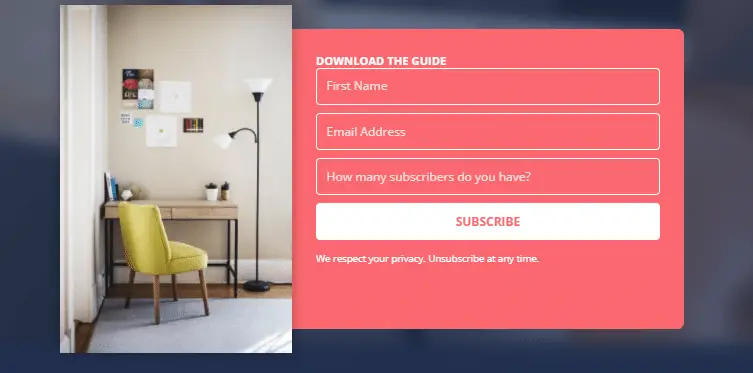
It gives you access to 100,000+ stock photos from Unsplash to make your landing pages meet the expectation of your audience. Whether it is on a PC, tablet, or smartphone, they look responsive.
ConvertKit’s landing pages have op-tin forms that can easily convert your visitors to subscribers. You can even offer them irresistible freebies just to have them exchange their email addresses and give you access to their inboxes.
Your digital products, services, and membership subscriptions can be sold through your landing page. And payments received through credit cards option integrated on it.
Verdict: No winner
Both Constant Contact and ConvertKit landing pages offer the standard features one will look for in a landing page.
You can set up your opt-in form, offer freebies to have your audience exchange their email addresses. Also, selling your digital products and receiving payments are possible.
5. Email Automation
Email automation is one of the trendy features in email marketing. Almost all the email marketing platforms support it because of its importance. Businesses want to do more with emails.
They want to send the right message to the right people using an automated workflow. The benefits are numerous. Consumers tend to take action with content that is tailored to their needs.
According to Statista, 90% of consumers find personalized and targeted content appealing. Let’s check out the email automation of Constant Contact and ConvertKit.
ConvertKit: Email Automation
ConvertKit has an email automation tool that is easy to use. It has an email automation platform with which you can send timely emails to a segmented contact.
Also, you can use events, actions, and activities of subscribers to customize a funnel.
This can take them on a buyer’s journey until they convert to sales. ConvertKit email automation integrates with other third-party apps which you may need to carry out your email marketing automation.
Below are what ConvertKit’s email automation tool helps you achieve:
Customize the path of subscribers base on the action they took.
Design robust automated marketing funnels.
Send targeted emails to the right subscribers at the right time.
Segment your contact base on engagement with your emails. This’s to help to target contacts that’re likely to take action on your offers.
Set up your email automation workflow and watch it do the work for you.
Constant Contact: Email Automation
Constant Contact’s email automation is aimed at helping small businesses improve engagement and results. You can send highly targeted emails to leads who’re interested in your business.
Personalized campaigns can be launched to reach out to contacts base on how they interact with your previous emails. Your contacts can be segmented to send content automatically to the right people, at the time.
You can trigger a resend if a subscriber doesn’t the email after a period of time
Constant Contact integrates with third-party apps like Shopify, Facebook to make your email marketing automation simple. For instance, you can send automated emails to customers who patronize your Shopify store for the first time.
Also, Facebook Lead Ads can be used to capture new subscribers and nurture them with automated welcome emails.
Verdict: No winner
Both have great ecommerce features for small businesses and creators respectively.
Convertkit and Constant Contact support email automation and have tools with which you can make it happen.
6. Ecommerce
Email marketing plays an important role in buying and selling online. Email marketing tools are now designed to exhibit features that will help merchants capture target customers, recover abandoned carts, drive sales, and overall grow an online store.
It’s on that basis that it’s necessary we examine the ecommerce features of Constant Contact and ConvertKit. This is to keep you informed in case you sell online or you plan to do.
Constant Contact: Ecommerce
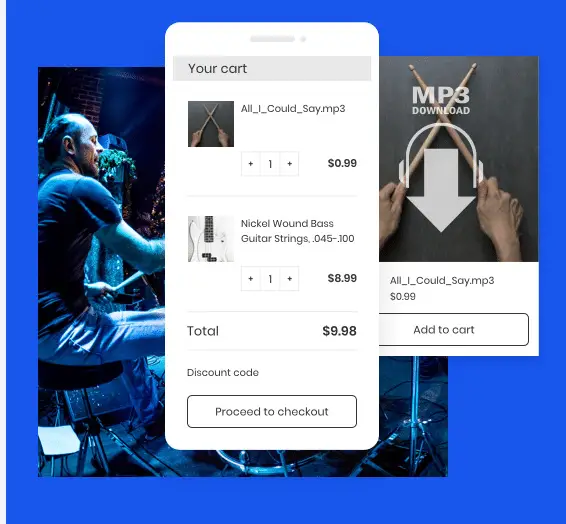
Constant Contact has features that allow you to build your online store and sell digital products like ebooks, music, video courses.
You can offer free shipping and discounts through redeemable codes to your loyal customers.
With its integrated shipping, the shipping cost of items per weight around the world is at your fingertips. Shipping confirmation and notifications are auto-generated.
What about your tax management? It’s automatically to the customer’s order when you turn on the tax calculation.
You can receive payment through Stripe, PayPal, Credit, and Debit cards.
ConvertKit: Ecommerce
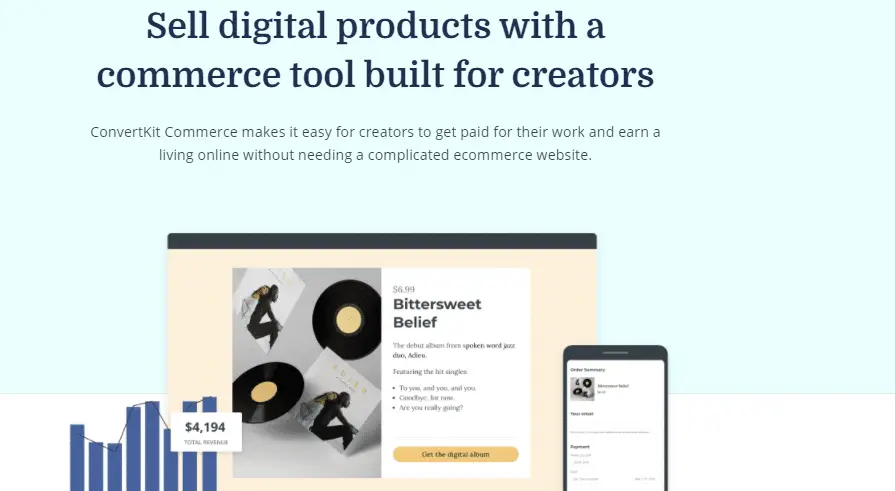
ConvertKit’s Commerce is what you need to start selling online as a creator.
It’s a simple ecommerce website that makes it easy for you to earn a living from your creative works. It simply works by adding your product and setting a price.
Next will be to customize it to suit your brand. Add a buy button to your ConvertKit landing page to drive your audience to your product. Alternatively, you can set up a sales funnel to automatically do the heavy lifting for you.
While you monitor performance from your dashboard. You can set up and integrate credit card payments on your sales page to receive payment.
Verdict: No winner
ConvertKit has ecommerce features that suit creators while Constant Contact has also ecommerce features that small businesses need.
7. A/B Testing
A/B Testing simply means comparing two different email subject lines to see which that got a higher open rate.
This is a compulsory feature you should look out for in any email marketing tool.
The aim is to identify an email campaign that subscribers engaged with and work on others that underperformed. Do Constant Contact and ConvertKit support A/B Testing? We will see below.
Constant Contact: A/B Testing
Constant Contact supports A/B Testing. It tests two subject lines to see which got a higher open rate. Here’s how it works:
- You create an email with two subject lines.
- Send the test to a portion of your audience.
- Constant Contact automatically sends the winner subject line to the remaining of your audience.
ConvertKit: A/B Testing
ConvertKit’s A/B Testing is similar to that of Constant Contact. 2 different email subject lines are tested against each other.
Each of the subject lines is sent to 15% of your subscribers in a testing period of 4 hours. ConvertKit automatically determines the winner subject line base on the open rate.
Verdict: No winner
Both email marketing platforms support A/B testing.
8. Pricing Plans
ConvertKit Vs Constant Contact comparison won’t be complete if we don’t discuss their pricing plans. This’s for you to know if they are what you can afford or make a budgetary provision for.
The pricing plans of these email marketing platforms are the monthly or yearly fee you pay before you can have access to all the features they offer.
It’s also important to note that their features vary according to the plan you subscribed to. The higher the plan, the more features, and the tools you have access to.
Let’s look at them.
Constant Contact: Pricing Plans
Constant Contact has 2 different pricing plans:
- Email: Starting from $20/month
- Email Plus: Starting from $45/month
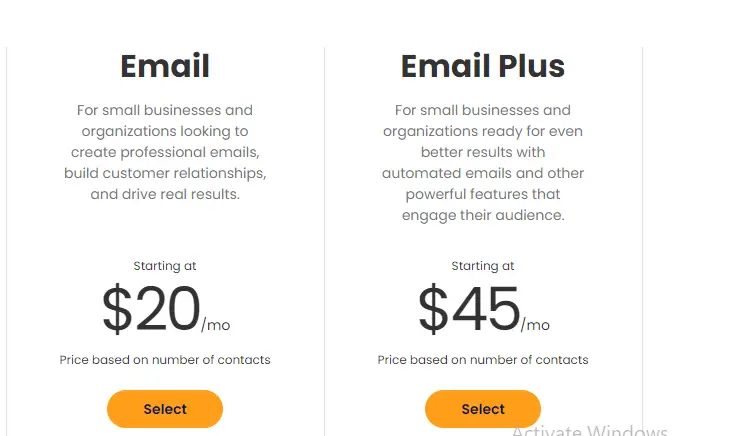
The amount you pay for any of these plans depends on the number of contacts. The higher the contact, the higher the amount you pay monthly or yearly.
However, to help you get started, Constant Contact offers you a 60-day free trial. This doesn’t require you to sign up with your credit card.
ConvertKit: Pricing Plans
ConvertKit offers 3 different pricing plans:
- Free plan: Allows only for a maximum of 1000 subscribers
- Creator: Starting from $25/ month
- Creator pro: Starting from $59/month
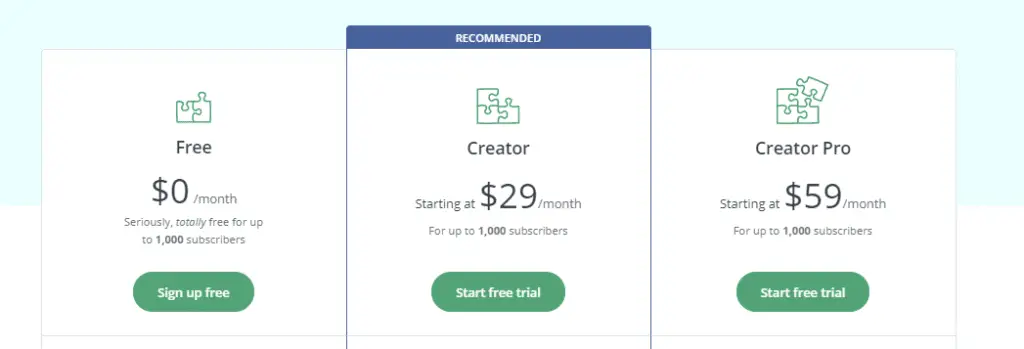
ConvertKit offers you two month free plan when you subscribe to its annual plan.
Verdict: ConvertKit wins
Both ConvertKit and Constant Contact have affordable pricing plans. But ConvertKit has an edge with its free plan that allows for a maximum of 1000 subscribers.
This will be a relief to a beginner who is on a low budget.
Constant Contact Vs Convertkit: Customer support
Customer support of these email marketing platforms is key to your success while using these tools. No matter how tech-savvy you’re, there’re some technical issues you can’t handle yourself.
You’ll need the assistance of customer support to fix issues. Both offer customer support but we need to check out the kind of support they provide.
Constant Contact: Customer support
Constant Contact offers support through live chat or phone support. You can connect with them on YouTube, Instagram, Pinterest, Twitter to be updated on the latest development.
There are also knowledge base articles with which you can read to resolves issues yourself. Constant Contact has video tutorials and webinars that can guide on how to resolve issues.
ConvertKit: Customer support
ConvertKit offers support through emails and live chat. At its support center, there are over 100 written articles on different topics that you can read to fix problems yourself.
Its Facebook, Instagram, and Twitter accounts are also means through which you can be updated.
That’s it with Constant Contact Vs ConvertKit comparison. Going further, I have collated some relevant information that will help you in your decision-making process.
That’s to look at the pros and cons of Constant Contact and ConvertKit
Constant Contact: Pros
- Smart email editor to customize and design any kind of email.
- Email marketing automation to help segment your contact, send the right content to the right people, and at the right time.
- Ecommerce tools to help you engage your customers, recover abandoned cart, and grow your online store.
- Create Facebook and Instagram Ads from your Constant Contact account.
- Upload your contact list from Outlook, Excel, Salesforce, etc.
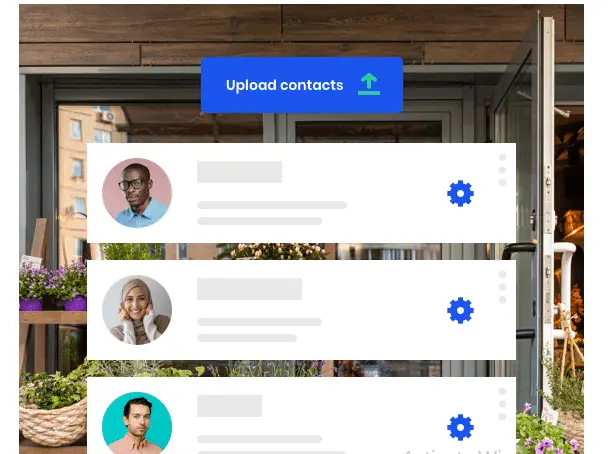
- Boasts of 97% deliverability rate.
- Supports A/B testing to test your email subject lines so as to ascertain the open rate.
- Integrates with other third-party apps.
- Offers 60 days free trial. You don’t need a credit card to sign up.
- Pricing plans are affordable.
- Offers customer support.
- It’s GDPR compliant.
- Beginner – friendly and easy to use.
Constant Contact: Cons
- No free plan.
- Constant Contact doesn’t offer discounts on its pricing plans.
- Customer support through email isn’t available.
ConvertKit: Pros
- Create simple and beautiful emails with the Email Designer.
- Offers a free plan.
- Boasts of a deliverability rate of 98%.
- You can integrate and connect with your favorite third-party apps.
- It’s GDPR compliant.
- Get a 2-month free plan when you subscribe to an annual plan.
- Sell your digital products, membership subscription, and receive payment on your landing page.
- Your email marketing can be automated.
- Offers a free trial.
- Supports A/B testing.
- Its pricing plans are affordable.
- Easy to use and beginner-friendly.
- Offers customer support through email and live chat.
ConvertKit: Cons
- No phone call support.
- A/B testing functionalities are limited.
Summary
Constant Contact and ConvertKit are two powerful email marketing tools that can serve you base on your needs.
It’s left for you to choose the one that best suits you based on their features, pricing plans, and customer support as compared above.
Place them side by side against what you want in an email marketing tool and make your final decision.
If you’re a blogger, YouTuber, social media influencer, podcaster, or any other kind of creator, ConvertKit is suitable for you.
Then for small businesses that are in need of smart email marketing features to attract target customers, boost sales, and grow their businesses, Constant Contact is worth giving a trial.

